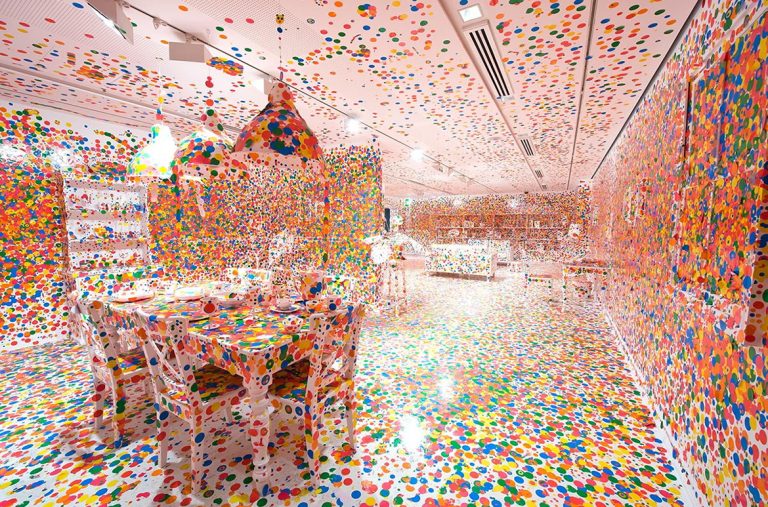Part 1: The Original Obliteration Room and Children “Play”
Kusama's Dots and the Obliteration Theory
Kusama was born in the rural provincial town of Matsumoto City, Japan in 1929 to a couple who owned a seed farm and to a generation that belongs to what the critic Tono Yoshiaki has described as the “post-Hiroshima generation.” Yoshiaki defined this generation as a group of Japanese artists who were shaped by a war-torn and destroyed Japan, which resulted in their shared interest in existential themes such as personal trauma, deviant mental states, deformity, and self-obliteration.[1] Similarly, in her autobiography, Kusama attributes her dot works to illusional experiences in her childhood when she had visions of herself physically plastered with floral patterning until she was “obliterated” by the patterns.[2]

Image credit to Formidable Mag. https://www.formidablemag.com/yayoi-kusama/.
The childhood psychological condition fertilized Kusama’s art. She titled her work The Obliteration Room after her theory of “obliteration,” the term used to describe a practice derived from obsession in which Kusama finds herself or others to be literally and metaphorically engulfed in patterning.[3] Kusama considers “obliteration” a way to confront her own psychological complexes directly, citing her mental health as the origin of her artistic practice, although this may possibly be based more in an effort to brand herself as an artistic genius rather than based in actuality.[4] Specifically, Kusama references a story from her childhood in which she experienced a hallucination that the red flowers from her family’s seed farm began to cover every inch of her room and her body which scared her and convinced her that she had become “obliterated,” or had become one with her surroundings.[5] Her practice of “obliteration” began with using her Infinity Net patterns, repeating and connecting curved lines, then expanded to her use of polka-dot patterning. Both utilize repeating simplistic shapes that cover large amounts of area, furniture, and occasionally participants and Kusama herself, until all objects are indistinguishable from each other, as is the case in painted, all-white Obliteration Room.

Yayoi Kusama, The Obliteration Room, 2012, QAGOMA.
Gift of the artist through the Queensland Art Gallery Foundation, 2012.
Collection: Queensland Art Gallery, Brisbane, Australia.
Locally sourced furniture and ornamentation, white paint, dot sheets.

Yayoi Kusama, The Obliteration Room, 2012, QAGOMA.
Gift of the artist through the Queensland Art Gallery Foundation, 2012.
Collection: Queensland Art Gallery, Brisbane, Australia.
Locally sourced furniture and ornamentation, white paint, dot sheets.
By instructing participants to use colored stickers to “obliterate” the white gallery space and white furniture, Kusama objected to the confines of the gallery space in a type of institutional critique. She is working within the museum space while simultaneously modifying how the museum experience plays out for guests. By “destroying” the museum space, she is thinking about ways in which the museum can be more interactive and engaging both for children and adults. The destructive impulse of “obliterating” a previously white space acts as a the carrying out of her institutional critique. The bright rainbow colors “obliterate” the gallery in the most forceful way possible, creating a stark contrast with the white walls. The white furniture mirrors a white-cube gallery space in which the art is delineated from the gallery with the use of framing and color.[6] The picture frame included in the décor of some of the installations also acts as institutional critique as it allows the audience to create art on a canvas within an art installation. The painted white space acts as an expansion of the white-cube gallery or white canvas space. Fully white museum spaces separate and individualize art pieces. By expanding the white canvas onto décor and furniture, Kusama has signaled that the entirety of the space and its furnishings are meant to act as a blank canvas for the application of art. She is, therefore, signaling that the entire space is meant to act as an enveloping artwork in which the art pieces are not segregated by frames but instead merge to become one full installation. The dots and collaboration involved in assembling the dots then become the art, with the white furniture acting as a base as much as the canvas acts as a base for the paint.
[1] Laurberg, “Amid Infinity,” 287; Midori Yamamura, Yayoi Kusama: Inventing the Singular / Midori Yamamura. (Cambridge, Massachusetts: The MIT Press, 2015): 10-12.
[2] Kusama, Infinity Net, 20.
[3] Yayoi Kusama, Infinity Net, 47.
[4] Kusama, Infinity Net, 47; In the later section on Branding, I further discuss Kusama’s conscious effort to create an artistic brand for herself as aligned with the “tortured artist.” I neither believe nor disbelieve this about her and instead would rather focus on the ways in which she outwardly defines herself through her own words like interviews and autobiographies.
[5] Kusama, Infinity Net, 69; Lenz, Kusama – Infinity, [10:08].
[6] Brian O’Doherty, Inside the White Cube: The Ideology of the Gallery Space / Brian O’Doherty; Introduction by Thomas McEvilley, 1st book ed. (Santa Monica: Lapis Press, 1986): 14-15.
